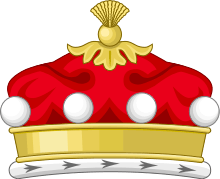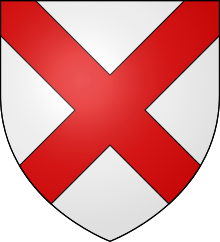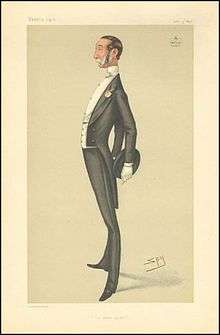Baron Gerard
There have been three baronies created for the Gerard family who lived historically at Bryn, Ashton-in-Makerfield, Lancashire and Kingsley, Cheshire, in the 13th century. The third and current barony was created in 1876.
| Barony of Gerard | |
|---|---|
  Argent, a saltire gules | |
| Creation date | 18 January 1876[1] |
| Creation | Third |
| Monarch | Queen Victoria |
| Peerage | Peerage of the United Kingdom |
| First holder | Robert Tolver Gerard, 1st Baron Gerard |
| Present holder | Anthony Gerard, 5th Baron Gerard |
| Heir apparent | Hon. Rupert Gerard |
| Remainder to | Heirs male of the first baron's body lawfully begotten |
| Former seat(s) | Bryn Hall Garswood Hall New Hall |
| Motto | En Dieu est mom esperance ("In God is my hope")[1] |
History
The Gerard family can be traced to William FitzGerald of Carew Castle in Pembrokeshire in the 12th century, whose brother Maurice FitzGerald went to Ireland, and is the ancestor of the Dukes of Leinster in the Peerage of Ireland. Within a few generations, the family name changed from FitzGerald to Gerrard and then Gerard in the 14th century. The Gerard family still shares the same arms as the FitzGeralds (argent, a saltire gules).[1]
First creation
The title Baron Gerard, of Gerards Bromley, was created in the Peerage of England on 21 July 1603 for Sir Thomas Gerard (d. 1617), son of Sir Gilbert Gerard (d. 1593) Attorney General between 1559 and 1581 and Master of the Rolls in 1581, who acquired estates at Gerards Bromley and Hilderstone, Staffordshire. The first Baron was Lord President of Wales between 1616 and 1617. The barony passed in direct line of succession until the death of the fifth Baron in 1684 when it passed to his second cousin Charles, and upon his death without a male heir, to his brother Philip Gerard, a Jesuit priest who died childless in 1773 when the barony expired.[2]
Second creation
For the title Baron Gerard of Brandon, in the County of Suffolk, created in 1645 for a great-grandson of Sir Gilbert Gerard (mentioned above), see Earl of Macclesfield.
Third creation
A Gerard Baronetcy was created in the Baronetage of England in 1611 for Thomas Gerard, Member of Parliament for Liverpool, Lancashire, and Wigan who was a direct descendant of the family of Bryn. He was succeeded by his son, the second Baronet. He also represented Liverpool in the House of Commons. His son, the third Baronet, was a Royalist during the Civil War and spent a large part of his estate in his support for King Charles I.[1] Thomas Gerard's second son was John Gerard the Jesuit priest who would later escape from the Tower of London.
The title of Baron Gerard of Bryn in the County Palatine of Lancaster,[3] was created in the Peerage of the United Kingdom in 1876 for Sir Robert Gerard, 13th Baronet.[1]
The title followed the line of the first Baron's eldest son until the death of the latter's grandson, the fourth Baron, in 1992. He was succeeded by his second cousin once removed, the fifth and present holder of the barony. He is the great grandson of Captain the Hon. Robert Joseph Gerard-Dicconson, second son of the first Baron. The family seat was originally Bryn Hall, Ashton-in-Makerfield, but later Garswood Hall, followed by New Hall, a majestic, modernist, building of considerable size.[1]
The current baron, Anthony Gerard, 5th Baron Gerard, was educated at Harvard University and lives in New York.[1]
Barons Gerard, of Gerards Bromley, first creation (1603)
_-_Portrait_of_Dutton%2C_3rd_Baron_Gerard%2C_of_Bromley%2C_Staffordshire.jpg)
- Thomas Gerard, 1st Baron Gerard (d. 1617)[2]
- Gilbert Gerard, 2nd Baron Gerard (d. 1622)[2]
- Dutton Gerard, 3rd Baron Gerard (1613–1640)[2]
- Charles Gerard, 4th Baron Gerard (1634–1667)[2]
- Digby Gerard, 5th Baron Gerard (1662–1684)[2]
- Charles Gerard, 6th Baron Gerard (1659–1707)[2]
- Philip Gerard, 7th Baron Gerard (1665–1733)[2]
Gerard Baronets, of Bryn (1611)
- Sir Thomas Gerard, 1st Baronet (1560–1621)[1]
- Sir Thomas Gerard, 2nd Baronet (c. 1584–1630)[1]
- Sir William Gerard, 3rd Baronet (1612–1681)[1]
- Sir William Gerard, 4th Baronet (1638–1702)[1]
- Sir William Gerard, 5th Baronet (1662–1721)[1]
- Sir William Gerard, 6th Baronet (1697–1732)[1]
- Sir William Gerard, 7th Baronet (1721–1740)[1]
- Sir Thomas Gerard, 8th Baronet (c. 1723–1780)[1]
- Sir Robert Gerard, 9th Baronet (c. 1725–1784)[1]
- Sir Robert Gerard, 10th Baronet (d. 1791)[1]
- Sir William Gerard, 11th Baronet (1773–1826)[1]
- Sir John Gerard, 12th Baronet (1804–1854)[1]
- Sir Robert Gerard, 13th Baronet (1808–1887) (created Baron Gerard in 1876)[1]
- Sir William Gerard, 14th Baronet (1851-1902) (2nd Baron Gerard)[4]
- Sir Frederick Gerard, 15th Baronet (1883-1953) (3rd Baron Gerard)[5]
- Sir Robert Gerard, 16th Baronet (1918-1992) (4th Baron Gerard)[6]
- Sir Anthony Gerard, 17th Baronet (b. 1949) (5th Baron Gerard)[7]
Barons Gerard, of Bryn, third creation (1876)

- Robert Tolver Gerard, 1st Baron Gerard (12 May 1808 – 15 March 1887). Gerard was the younger son of John Gerard and his wife Elizabeth (née Ferrers). He succeeded his elder brother in the baronetcy in 1854. In 1876 he was raised to the peerage as Baron Gerard, of Bryn in the County Palatine of Lancaster. Lord Gerard married Harriet, daughter of Edward Clifton, in 1849. He died in March 1887, aged 78, and was succeeded in his titles by his son William. Lady Gerard died in 1888.[1]
- William Cansfield Gerard, 2nd Baron Gerard (1851–1902). His daughter Ethel (1881-1966) married the Liechtenstein nobleman Baron Arnold Maurice de Bendern.[1]
- Frederic John Gerard, 3rd Baron Gerard (1883–1953)[1]
- Robert William Frederick Alwyn Gerard, 4th Baron Gerard (1918–1992)
- Anthony Robert Hugo Gerard, 5th Baron Gerard (b. 1949)[1]
The heir apparent is the present holder's son Hon. Rupert Bernard Charles Gerard (b. 1981).[1]
References
- Mosley, Charles, ed. (2003). Burke's Peerage, Baronetage & Knighthood (107 ed.). Burke's Peerage & Gentry. p. 1535. ISBN 0-9711966-2-1.
- Burke, Bernard (1866). A Genealogical History of the Dormant, Abeyant, Forfeited, and Extinct Peerages of the British Empire. Harrison. pp. 229–230. Retrieved 20 June 2017.
- "No. 24283". The London Gazette. 11 January 1876. p. 99.
- "Person Page". thepeerage.com. Retrieved 15 August 2019.
- "Person Page". thepeerage.com. Retrieved 15 August 2019.
- "Person Page". thepeerage.com. Retrieved 15 August 2019.
- "Person Page". thepeerage.com. Retrieved 15 August 2019.